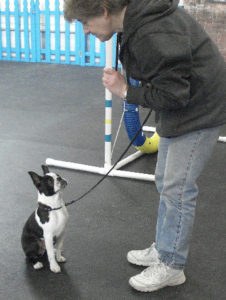
Your dog’s face is adorable. But you don’t have to look at it all the time. In fact, when you’re training, “face time” should be half or less.
When dogs first join the family, training starts right away. The first behavior most people start with is “sit.” You stand, facing your dog and say “sit!” You may even use a lure, holding it over the dog’s head and moving it so the dog naturally moves into sit position. You praise your good dog – “Good sit, Fido! Good sit!”
Context is everything to a dog
After a few sessions doing this, most people believe their dogs know “sit.” Perhaps – as long as those exact conditions are repeated. As we’ve discussed before, dogs learn in context. Fido knows sit, as long as a treat is held over his head, you’re standing in front of him for face time, and the lure is moved in exactly the same way.
It’s the same situation for any behavior. Down is one we see often – the dog does it as long as the owner is standing facing the dog, bends over, holding a treat, lowers the treat to the floor while saying “down.”
Change any one of those contextual cues, and the dog may look at you as if she’s never heard the word “sit” or “down” before. It can be frustrating for owners – they absolutely know their dog “knows” it. He just did it a little while ago at home.
Fix face time – fast!
Fortunately, the “cure” is simple. It doesn’t take long, and it’s easy to do. Start by changing your position. Stand next to your dog, instead of in front, and see what response you get. If your dog is still performing “sit,” that’s great! Try sitting yourself and telling your dog to sit. Still knows it? Fantastic!
Training note: Regardless of your position, your reward should always be delivered to your dog’s front. Even if you’re behind your dog, reach forward and deliver the treat to the “front.” This teaches the dog that he doesn’t have to “help” you – he can stay in place and still be rewarded for good choices.
Just start over – someplace else
If, however, your dog is giving you a blank stare, start at the beginning. If you’ve used a lure to teach it in the past, use the exact same sequence, just from a different angle. Expand your range – do it from any position around your dog; to his left, to his right, even behind. As long as the treat is delivered to his face, in a short time you should be able to walk completely around your dog, while she maintains position.
This exercise is the start of a good “stay” behavior as well as the position sit or down. And it’s useful not just for those who want to play dog sports with their dogs. It’s also useful for visits to the veterinarian, the groomer, or anyplace your dog needs to stay in place.
